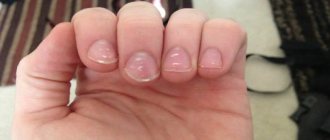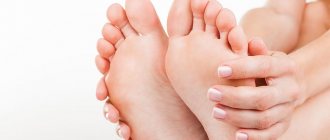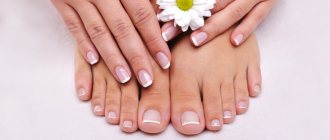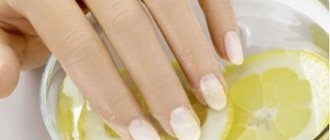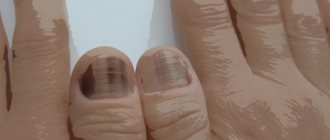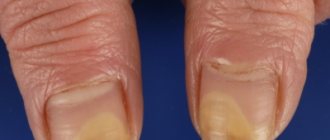Beau's lines (Beau Reil's grooves) are transverse grooves up to 1 mm deep, crossing the nail plate from one edge of the nail fold to the other. They usually appear after stress, food poisoning or mechanical trauma to the nail, but may indicate the presence of a chronic fungal or infectious disease, or problems with the cardiovascular system.
- SYMPTOMS AND REASONS FOR THE APPEARANCE OF BO LINES
- DIAGNOSTICS
- CLASSIFICATION OF BEAU-REILLE FROWS
- TREATMENT OF BO LINES ON NAILS
- PHOTOS BEFORE AND AFTER TREATMENT AT THE PODOLOGY CLINIC
Symptoms and causes of Bo lines
Transverse Beau-Reil grooves, which occur due to a chronic disease, make the nail plate wavy. When a nail is injured, the appearance of the pathology can change: from depressed grooves no more than 1 mm deep to typical linear defects. Usually the color of the nail plate does not change, but sometimes it becomes yellowish.
Mostly, Beau's lines occur due to injury to the nail fold or skin during a manicure. They can also form 1-2 weeks after infectious, nervous and systemic diseases, in which the nutrition of the nail growth zone occurs. They are usually localized on the nail plates of the first, second and third fingers, but are also found on the nails of the lower extremities.
Often Bo's furrows appear due to the fact that a person himself damages the nail plates. The reasons may be different: psychological disorders, stress, bad habit of biting nails and biting the skin on the fingers. As a result, the growth zone of the nail plate is injured, and it grows back modified.
Isolated acquired onychodystrophies
The category of isolated onychodystrophies includes those that occur independently without connection with other diseases. Most often they are the result of adverse mechanical, chemical and ultraviolet effects. These include increased fragility of nails, the formation of longitudinal grooves, onycholysis and others. In general, they cause only a cosmetic defect and do not pose a danger. To restore the health of the nails (with rare exceptions) in such situations, it is enough to eliminate the cause of the development of onychodystrophy.
Brittle nails
Increased fragility of nails is the most common type of onychodystrophy, which consists in breaking off the free edge of the nail plate along the entire thickness. In most cases, women face a similar problem due to the depletion of their nails by frequent manicures, especially those carried out in violation of the rules, or frequent contact with hot water or chemicals.
Onychoschisis
This term means transverse separation of the nails without the occurrence of other disorders and signs of inflammation. With onychoschisis, the free edge of the nail splits into 2 or even 3 layers, and no changes are observed in the rest of it. Most often, the nail plates of the index, middle and ring fingers are affected, since they are the ones that are most injured in everyday life. In addition, an addiction to playing stringed musical instruments and improperly performed manicure can provoke splitting of nails.
Furrows Bo
Bo's groove is the formation of a transverse notch on the nail plate, which is a direct consequence of mechanical injury. This is also called manicure onychodystrophy, since the main cause of such dystrophy is a violation of the technique of removing gel polish with a cutter or injury from other manicure tools.
Longitudinal furrows
Longitudinal grooves are faintly defined individual or multiple lines on the surface of the nails, which can be present both in cases of dysfunction of the matrix and in healthy people. The main reason for the formation of longitudinal furrows is considered to be zinc deficiency in the body, which most often affects adherents of a vegetarian diet. Although such a nail defect can also be a consequence of:
- careless manicure with severe injury to the cuticle, which often occurs when the manicure is cut too deep;
- matrix damage;
- decreased immunity due to certain reasons;
- frequent stress.
Onycholysis
Onycholysis is a common type of onychodystrophy, in which there is detachment of part of the nail plate from the bed. As a result, the separated part of the nail may become paler with a grayish tint, although the surface itself remains smooth and has a normal structure. However, when a bacterial or fungal infection is attached, it becomes rough, lumpy, and may thicken and become brittle.
Onycholysis can be a consequence of a variety of factors:
- mechanical trauma or prolonged compression of the nail;
- chronic dermatoses, pathologies of the endocrine, nervous, cardiovascular systems and gastrointestinal tract;
- taking antibiotics, in particular the group of tetracyclines and fluoroquinolones;
- a diet poor in vitamins and minerals, leading to the development of hypovitaminosis;
- use of low quality varnishes for manicure;
- behavioral disorders in the form of the habit of biting and breaking nails, including using various devices.
Onychogryphosis
Onychogryphosis is an onychodystrophy, accompanied by a sharp thickening of the nail plate, a change in their color to dirty yellow or even brown and twisting into a spiral or in the form of a horn. The reasons for the development of this type of disease are still unknown, although it is believed that both exogenous and endogenous factors are simultaneously involved in its occurrence. These may include nail injuries, frostbite, infections, wearing uncomfortable, too-tight shoes, chronic skin diseases, immunodeficiencies, age-related hormonal changes, and even varicose veins of the lower extremities.
Leukonychia
Leukonychia is one of the most common types of onychodystrophy, which is characterized by the appearance of white spots and stripes of various sizes in the thickness of the nail. Depending on the characteristics of nail damage, the following forms of leukonychia are distinguished:
- dotted or stripe-shaped - white spots that appear in the thickness of the nail move along with the nail and are subsequently cut off and do not form in the future;
- subtotal - white spots are persistent and occupy a significant part of the nail plate;
- total – almost the entire surface of the nail becomes white, the changes are permanent.
There are many reasons for the development of leukonychia. Most often it occurs against the background of a deficiency in the body of vitamins and minerals, in particular calcium, zinc and potassium. White spots can also be caused by violating the rules of manicure, using low-quality varnish, wearing shoes that are too tight, or frequent contact with chemical compounds.
Hyperpigmentation
Hyperpigmentation of nails is onychodystrophy, manifested by yellowing or browning of the nails over the entire surface or only part. This may occur when taking tetracycline and resorcinol when treating bacterial or other infections. In such cases they talk about drug-induced hyperpigmentation. But also a change in the color of the nails can occur with prolonged use of manicure varnishes, then chemical hyperpigmentation is diagnosed.
Classification of Beau-Reil's grooves
Bo lines on nails are conventionally distinguished by the number and depth of damage to the nail:
- superficial lines are a symptom of minor metabolic defects in the body, deep damage indicates a severe metabolic disorder;
- one groove indicates a recent development of the disease, and multiple dents indicate a chronic pathological process.
By the number and distance of Bo stripes from the growth line of the nail plate, one can estimate the duration of relapses and the frequency of exacerbations of the underlying disease.
Reasons for development
Onychodystrophy can occur against the background of internal and external factors leading to changes in the course of trophic processes in the nails. The first include:
- chronic skin diseases, in particular eczema, atopic dermatitis, lichen planus, psoriasis;
- endocrine diseases, including diabetes mellitus, hypothyroidism, thyrotoxicosis;
- gastrointestinal pathologies, including gastritis, gastric ulcer;
- iron deficiency in the body and resulting anemia;
- decreased immunity due to a lack of vitamins, minerals, the presence of chronic diseases, immunodeficiencies;
- oncological diseases;
- intoxication;
- frequent stress;
- cardiovascular disorders.
However, more often onychodystrophy is caused by external factors, including:
- fungal and bacterial infections of nails;
- nail injuries, improper manicure;
- the influence of chemicals, including those contained in household chemicals, paints and varnishes, etc.;
- frequent exposure to ultraviolet rays on nails;
- living in unfavorable environmental conditions.
Therefore, onychodystrophy is most often diagnosed in women who regularly perform manicures, including in specialized manicure salons, and work with household chemicals without using gloves.
Treatment of Beau lines on nails
Bo's superficial grooves do not require special therapy. If you do not injure the growth area of the nail plate, a healthy nail will grow over time and the linear depressions on its surface will disappear. Regular procedures of medical hardware manicure and pedicure with careful cleaning of the nail plate and its treatment with strengthening agents help solve the problem. It is also important to balance your diet, and in case of identified deficiency of vitamins and microelements, take multivitamin complexes.
Multiple and deep lines indicate severe metabolic disorders in the body. In this case, a comprehensive examination and treatment of the patient is carried out with the involvement of specialists competent in the treatment of the underlying pathology.
Important! Beau's lines are a podological pathology and when they appear, you should contact a podologist, not a dermatologist. Only podiatry methods can solve the problem and achieve complete restoration of the structure and shape of the nails.
Are Beau lines appearing on your nails? Don’t cover them with gel polish, contact the Podology clinic and restore the beauty of your nails!
Diagnostics
The diagnosis of the described disease is made on the basis of the patient’s complaints, details of the anamnesis (history) of the disease, and the results of additional research methods (physical, instrumental, laboratory). At the same time, complaints about changes from not only the nail plates, but also other structures are taken into account. Therefore, other specialists may be involved for consultation - a therapist, a cardiologist, a gastroenterologist, an endocrinologist, a phthisiatrician, and so on.
From the patient's medical history, it is determined whether he suffered from any pathologies of other organs and systems, or whether he had injuries to his fingers.
During the physical examination, the following actions are carried out:
- during examination - the characteristics of Bo's lines are assessed, the lines on the nail plates of different fingers are compared;
- during palpation (palpation) - the degree of smoothness/roughness of the nail plate at the site of formation of Bo lines is assessed.
Instrumental diagnostic methods include examination of the nail plates using a magnifying glass.
Important
Bo's lines are a rather ambiguous pathology in the diagnostic process. Having identified them and assessed the condition of the nail plates, the complex of diagnostic examinations is often expanded to identify and study the diseases that provoked this disorder.
To optimize the diagnostic process, a consultation with related specialists is first conducted, who will prescribe the necessary examination methods. Typically this is:
- electrocardiography (ECG) – a graphic recording of biopotentials generated in the myocardium is carried out, and based on changes in its parameters, conclusions are drawn about the state of the myocardium;
- Chest X-ray – assesses the condition of the lungs and heart;
- spirometry - conduct breathing tests based on assessing the parameters of inhalation, exhalation, breath holding, and so on. They will allow you to assess the functional ability of the respiratory (breathing) system of the body;
- fibroesophagogastroduodenoscopy (FEGDS) - the esophagus, stomach and duodenum are examined from the inside using a fiberscope (a type of endoscopic equipment), signs of organic pathologies are identified;
- Ultrasound examination of the abdominal organs (ultrasound) - assess their condition.
Of the laboratory methods, a general blood test is most often performed, which will reveal the nature of the disease that provoked the occurrence of Bo lines.
What causes onychodystrophy?
They arise from birth or are acquired during life.
Congenital nail dystrophies are a consequence of fetal malformations, genetic abnormalities, and a family history. Acquired ones arise against the background of injuries, improper care, infections, chronic diseases, and trophic disorders.
Unfortunately, the causes of nail onychodystrophy cannot always be determined, since sometimes they are provoked by various factors.
Onychodystrophy of toenails is caused by improperly selected or inappropriate shoes.
In addition to general reasons, there are specific ones, when changes are associated with specific factors.
More often, onychodystrophy occurs in women. Continuous wearing of artificial coverings and gel polish plays an important role in this. Onychodystrophy of nails from shellac manifests itself in the form of fragility, delamination, onycholysis of transverse grooves, leukonychia.
What to do in case of onychodystrophy?
Symptoms can be ambiguous, so if you detect the slightest deviation, contact a podologist or dermatologist. It is impossible to independently make a correct diagnosis, identify the type and causes of onychodystrophy based on reviews on forums on the Internet. Knowledge of medicine and understanding of the mechanisms of pathological changes are needed. Sometimes several variants of onychodystrophy are present at the same time, which makes diagnosis difficult.
First, the doctor will examine your nails. Assess the color, transparency, condition of the cuticle, shape of the plate, tightness of fit to the nail bed. Then he will ask about accompanying symptoms, lifestyle, work, nail care, and general diseases.
In the presence of any type of onychodystrophy of the hands and feet, the affected areas are analyzed for fungus, since it causes 50% of all nail diseases. In case of doubtful results, the test is repeated 2–3 times at intervals to accurately verify the absence or presence of the pathogen. The treatment tactics depend on this analysis. When a fungal infection is confirmed, the emphasis is on fighting the pathogen; after its destruction, the nail plate itself will recover.
If the diagnosis of onychomycosis is made incorrectly, then medications against the fungus will not work, and the condition of the nail will not improve. In addition, unjustified therapy with fungicidal agents is harmful to health.
Why nails become ribbed - restoration remedies
Often, vertical or horizontal grooves appear on the fingernails, which can be caused by various physiological or pathological factors.
Let's find out the causes and treatment methods to get rid of grooves on the nails.
Ribbed nails: what they look like
Nails are formed from a biological matrix consisting of minerals, vitamins, fatty acids and amino acids. For various reasons, sometimes horizontal or vertical grooves appear on the nails, white spots may also appear, or the nails become thin and brittle.
Let's take a look at the different types of ridged nails :
- Vertical grooves on nails: Typically, grooves run from the base to the tip of the nail. Such grooves may be accompanied by brittle nails and the appearance of white spots.
- nails with horizontal grooves: as a rule, the phenomenon affects only one nail, and the appearance of grooves is accompanied by blackening or yellowing.
- wavy grooves on the nails: the appearance of wavy striae on the nail may be accompanied by a thickening of the nail plate.
- Nails turn yellow: One or more fingernails or toenails may develop a yellowish tint without streaks.
- Ridged nails in children: Sometimes grooves appear on the nails of children, which is usually associated with nail brittleness.
Causes of grooves on nails
Let's look at the main factors that cause changes in the nails:
Vertical grooves on nails:
- Nutritional deficiencies. The most common cause of the formation of vertical grooves on the nails, even in children, is a lack of vitamins or microelements in the diet. Vitamin C deficiency, for example, leads to dry skin and ridged nails because vitamin C is critical for the formation of collagen, a protein fiber that gives structure to tissues such as nails. Iron deficiency can cause streaky nails because this element is part of the nail matrix. A deficiency of calcium, an important component of the nail, causes the appearance of grooves, stripes and brittleness of the nails.
- Enteropathies. Sometimes iron and vitamin deficiencies can be the result of diseases that impair the absorption of nutrients in the intestines. For example, celiac disease, in which inflammation of the intestines interferes with the absorption of important nutrients such as iron, calcium and vitamins.
- Chemical substances. Harsh cleansers can damage the nail, causing white streaks and weakening of the nail plate.
- Stress. Physical and mental fatigue compromises the proper functioning of certain organs, such as the intestines, causing, through the loss of vitamins and mineral salts, the formation of ribbed nails.
Horizontal grooves on nails:
- Injuries. Horizontal stripes can be the result of injury, a blow to one or more nails, leading to the formation of a hematoma under the nail plate. Often such grooves appear on the toenails due to impacts or friction from uncomfortable shoes.
- Medicines. When horizontal stripes appear on all toenails and fingernails, the cause may be the use of medications such as antibiotics, one of the side effects of which is a change in the process of nail formation.
- Psoriasis. That is, an autoimmune disease that causes thickening of the skin in certain areas of the body, such as the knees, elbows, arms and legs. But it can also affect the nails, in which case thin, horizontal stripes and white spots appear on them.
Nails with wavy grooves:
- Microtraumas. The most common cause of the appearance of wavy grooves on one or more nails is a temporary blockage in the synthesis of areas of the nail matrix caused by a local interruption of blood flow. These grooves, known as Beau's lines, can appear as a result of chemotherapy or as a result of certain diseases characterized by impaired circulatory function, such as heart disease, Raynaud's syndrome, diabetes.
- Thyroiditis. Some pathologies of the thyroid gland of an autoimmune nature can cause serious changes in the fingernails and toenails, including detachment of the nail plate. This occurs because antibodies that attack the thyroid gland can aggressively attack the connective tissue structures of the nail due to their molecular similarity.
Regardless of the type of groove, very often, especially if the nail turns yellow, the cause is onychomycosis , that is, a fungal infection that can affect the toenails or fingernails.
How to cure ridged nails
The first step to treating ridged nails is without a doubt a visit to a dermatologist.
Correct diagnosis of the causes of the pathology is important for effective treatment:
- Manicure and protective varnishes. If the cause of the grooves is injury or improper use of detergents, it is enough to use protective nail polish. It is very helpful to use hand moisturizer daily to soften and moisturize your nails.
- Biologically active additives. A deficiency of mineral salts can be compensated by taking appropriate supplements (iron, calcium, magnesium), but we must remember that it is always better to follow a healthy and varied diet, including daily consumption of fruits and vegetables as the main sources of vitamins and mineral salts.
- Antifungal drugs. In the case of onychomycosis, the dermatologist will prescribe antifungal drugs aimed at removing the pathogen.
There are also natural treatments that counteract the appearance of ridged nails, for example, vegetable oils such as olive oil, almond oil, coconut oil, which nourish and soften the nail.
General information
Bo's lines are a pathology of the nail plate in the form of transverse linear depressions resulting from damage to the growth zone of the nail. The arched Beau-Reilly stripes were first described by the French military surgeon Joseph Honore Simon Beau in the mid-19th century, having noticed this symptom in many wounded soldiers. He called the cause of this nail pathology a temporary stop in their growth as a result of injury and stress. Modern dermatologists believe that transverse lines are nothing more than the result of trophic disorders of the nail matrix, changing its chemical composition. Taking into account the fact that the nail plate grows completely in approximately 90 days, the distance from the nail fold (the point at which the nail begins to grow) to the Beau line can be used to determine the time of injury or how long ago the chronic pathology that caused the nail changes has existed. The pathological process does not have a gender component, although Beau's Lines are called manicure onychodystrophy, does not have seasonal or age-related characteristics, and is non-endemic.
Onychodystrophy as a sign of other diseases
A much more serious problem than isolated onychodystrophies are those that arise as a result of the development of other disorders in the functioning of the body. In such situations, patients require comprehensive treatment aimed at eliminating existing diseases and improving nail nutrition.
Onychorrhexis
Onychorrhexis is onychodystrophy, accompanied by longitudinal separation of the nail plate in any part of it, including at the base of the nail. Such changes may signal the development of chronic dermatosis, most often caused by frequent contact with specific chemicals.
Scleronychia
Scleronychia is a clear manifestation of endocrine diseases, i.e. hormonal imbalances as a result of excessive or, conversely, insufficient function of one or another endocrine gland. This type of onychodystrophy is characterized by a change in the color of the nail to yellow-brown, but unlike hyperpigmentation, this is accompanied by its thickening, loss of elasticity and transparency. Subsequently, the nail may separate in places from the nail bed, as with onycholysis. Sometimes the lunula disappears.
Trachyonychia
Trachyonychia is an uncommon type of onychodystrophy, characteristic of immunodeficiency states. It is characterized by paleness of the nail plate, loss of natural shine and the formation of small scales on it. The lunula has also disappeared.
Thimble-shaped nails
This form of the disease is characterized by the formation of small depressed dots on the surface of the nail, as if from a needle. This can happen when:
- psoriasis;
- lichen planus;
- exfoliative dermatitis;
- alopecia areata.

